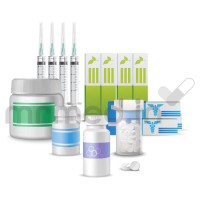Lubic Jelly is a lubricating agent that contains vegetables, glycerine, propylene glycol, and synthetic gums. It is commonly used to diagnose or treat vulvar irritation, vaginal dryness, any vaginal discomfort, menopause-related dryness, and painful intercourse. Vaginal dryness can occur due to various reasons such as hormonal changes, menopause, stress, breastfeeding, diabetes, inflammatory bowel disease, nervous disorder, heart problems, and cancer treatment. It has side effects such as mental activity changes and growth rate alteration.
Lubic Jelly is used in gynecological and hospital applications, catering to female reproductive health and medical procedures. It plays a pivotal role in easing the insertion of surgical instruments like catheters, scopes, and rectal thermometers, as well as facilitating procedures involving enemas and douches. Additionally, its attributes make it an optimal choice as a contact material for electrocardiogram (ECG) tests, aiding in accurately detecting heart issues.
Do not use Lubic Jelly if you are allergic to glycerine, propylene glycol, synthetic gums, or any of its ingredients. Before using the medicine, if you have allergies, if there are cuts, irritations, sores, or wounds near the intended application site, if you are pregnant or breastfeeding, or if you have a sexually transmitted infection (also referred to as a sexually transmitted disease or STD). Inform your doctor if you are pregnant, planning to get pregnant, or think you may be pregnant or are breastfeeding. Notify your doctor if you have or have had a history of any disease. No common side effect is seen in this medicine; if you notice any symptoms, contact your doctor immediately.
Therapeutic Effects of Lubic Jelly
Pregnancy
It is unknown whether Lubic Jelly is harmful to the unborn baby. Notify your healthcare professional if you are pregnant or planning to have a baby think you may be pregnant.
Breast Feeding
It is unknown whether Lubic Jelly is excreted in breast milk. So, before starting the treatment, inform your doctor if you are breastfeeding. Contact your doctor for more information.
Lungs
It is unknown whether Lubic Jelly is safe for patients with lung problems. Inform your physician if you have any lung disease before starting the treatment. Contact your doctor if you experience any lung-related symptoms.
Liver
It is unknown whether Lubic Jelly is safe for patients with liver problems. Inform your physician if you have any liver disease before starting the treatment. Contact your doctor if you experience any liver-related symptoms.
Alcohol
It is unknown whether consuming alcohol while taking Lubic Jelly is safe. Please speak with your physician.
Driving
It is unknown whether Lubic Jelly alters driving ability. However, if you experience side effects like tiredness or drowsiness, avoid driving and using machines.
There are no specific dietary restrictions associated with Lubic Jelly. However, it is recommended to maintain a healthy and balanced diet to support overall health and well-being.
The time it takes for the Lubic Jelly to start working varies from person to person. However, continuing the medication as your healthcare provider prescribes is important for optimal treatment outcomes.
Pregnant women should consult their doctor before using Lubic Jelly to weigh potential risks and benefits.
Apply a small amount of Lubic Jelly to the intended area, ensuring even coverage, and reapply as necessary. Wipe away excess post-use, and follow product instructions. If uncertain, consult a healthcare professional. Your doctor will decide the dose, route of administration, and frequency based on your disease condition and other factors.
It's crucial to consult a medical professional before using this product, especially if you have any known allergic conditions or medical ailments. Seeking medical advice helps ensure safe and appropriate usage.
Molecule name: Lubricating Jelly | Therapeutic class: Topical agent |
Pharmacological class: Lubricating agent | Indications: 1. Vulvar irritation or discomfort 2. Menopause-related dryness 3. Painful intercourse |






